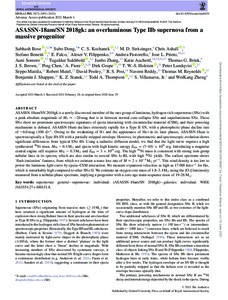ASASSN-18am/SN 2018gk: an overluminous Type IIb supernova from a massive progenitor
Bose S; Dong SB; Kochanek CS; Stritzinger MD; Ashall C; Benetti S; Falco E; Filippenko AV; Pastorello A; Prieto JL; Somero A; Sukhbold T; Zhang JB; Auchettl K; Brink TG; Brown JS; Chen P; Fiore A; Grupe D; Holoien TWS; Lundqvist P; Mattila S; Mutel R; Pooley D; Post RS; Reddy N; Reynolds TM; Shappee BJ; Stanek KZ; Thompson TA; Villanueva S; Zheng WK
https://urn.fi/URN:NBN:fi-fe2021093047941
Tiivistelmä
ASASSN-18am/SN 2018gk is a newly discovered member of the rare group of luminous, hydrogen-rich supernovae (SNe) with a peak absolute magnitude of MV ≈ -20 mag that is in between normal core-collapse SNe and superluminous SNe. These SNe show no prominent spectroscopic signatures of ejecta interacting with circumstellar material (CSM), and their powering mechanism is debated. ASASSN-18am declines extremely rapidly for a Type II SN, with a photospheric-phase decline rate of ∼6.0 mag (100 d)-1. Owing to the weakening of H I and the appearance of He I in its later phases, ASASSN-18am is spectroscopically a Type IIb SN with a partially stripped envelope. However, its photometric and spectroscopic evolution shows significant differences from typical SNe IIb. Using a radiative diffusion model, we find that the light curve requires a high synthesized 56Ni mass MNi ∼0.4 M⊙ and ejecta with high kinetic energy Ekin = (7-10) x 1051 erg. Introducing a magnetar central engine still requires MNi ∼0.3 M⊙ and E-kin = 3 x 1051 erg. The high 56Ni mass is consistent with strong iron-group nebular lines in its spectra, which are also similar to several SNe Ic-BL with high 56Ni yields. The earliest spectrum shows 'flash ionization' features, from which we estimate a mass-loss rate of Ṁ ≈ 2 x 10-4 M⊙ yr-1. This wind density is too low to power the luminous light curve by ejecta-CSM interaction. We measure expansion velocities as high as 17 000 km s-1 for Hα, which is remarkably high compared to other SNe II. We estimate an oxygen core mass of 1.8-3.4 M⊙ using the [O I] luminosity measured from a nebular-phase spectrum, implying a progenitor with a zero-age main-sequence mass of 19-26 M⊙.
Kokoelmat
- Rinnakkaistallenteet [27094]
